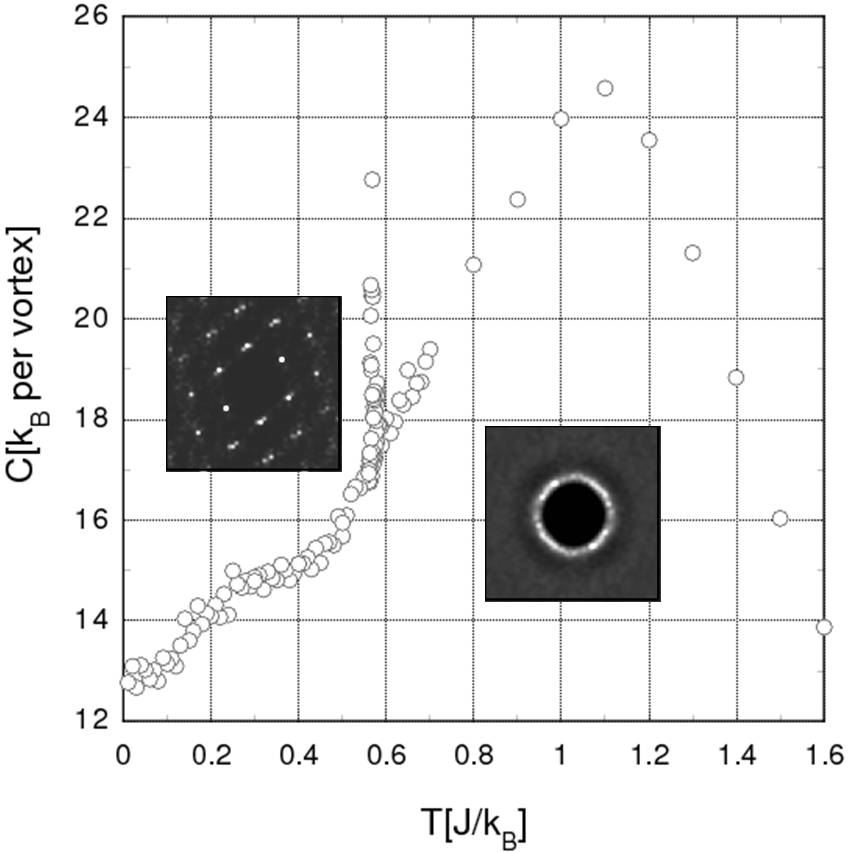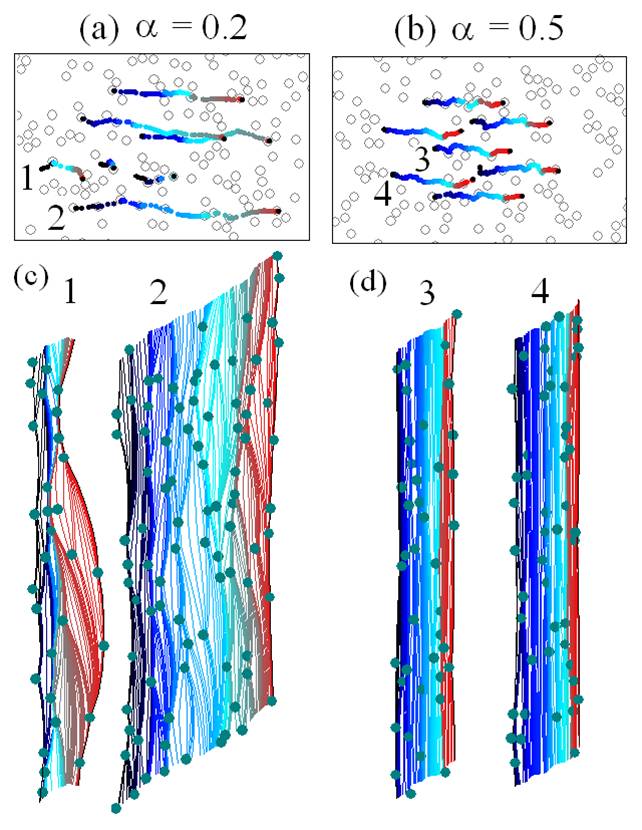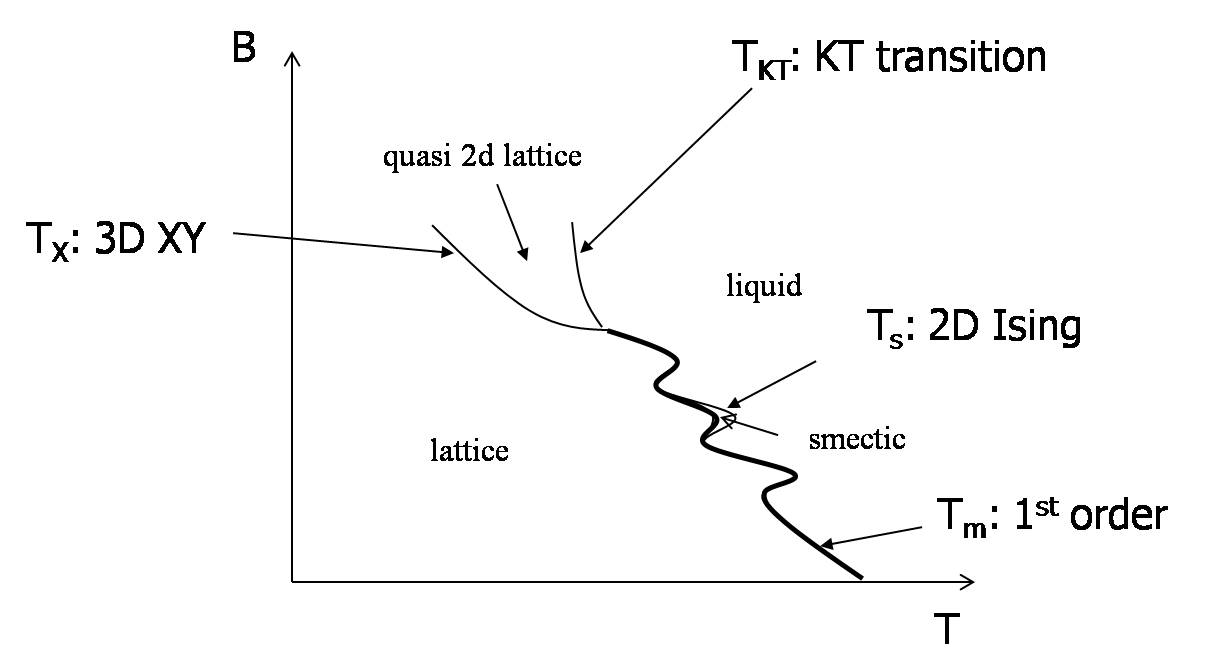It is well known that a magnetic field penetrates into a type-II superconductor in the form of quantized flux tubes, or vortices. The presence of a fluctuating vortex line reduces the superfluidity of the system, and its motion is the primary cause of energy dissipation in a superconductor. On the other hand, a controlled use of vortices has been adopted in building the strongest magnets, and may play central roles in several quantum computation algorithms or in other future electronic devices. Given these reasons it is apparently vital for applications to know how to gain control over these objects.
1) First-order vortex lattice melting
The conventional T-H phase diagram of a type-II superconductor consists of three phases; the Meissner phase where magnetic fields are totally expelled, the vortex lattice phase where the vortices form a regular (triangular) lattice, and the normal phase. This is based on a mean-field analysis, which becomes inapplicable in the high-Tc cuprate superconductors (HTSC) where thermal fluctuations are large due to the strong anisotropy of the cuprates, and the fact that they are strongly type-II superconductors. A new picture had been advanced in its place, where the vortex lattice undergoes a melting transition (just like the melting of an ordinary crystal lattice), leading to the destruction of superconductivity. Despite some experimental indications of such behavior, the precise thermodynamic properties of the transition had not been evaluated and understanding the behavior of this unique vortex system poses a big scientific challenge.
By Monte Carlo simulations, we found when fixing the magnetic field while sweeping the temperature a prominent peak in the specific heat corresponding to the first order melting transition, as evidenced from the change in the structure factors above and below this point. This is also accompanied by the vanishing of the helicity modulus which measures the superfluidity of the system. A similar specific heat peak was confirmed in experiments at around the same time.

Figure:Temperature dependence of the specific heat, with the sharp peak associated with the latent heat of the first-order melting transition. Inset: structure factors for the triangular lattice phase and the liquid phase.
For more details, please refer to the attached pdf file
2)
Physics of glass states of vortices
There are always some amount of point-like crystalline defects such as oxygen deficiencies in actual samples which trap segments of vortex lines. In such systems, the combined effects of strong thermal fluctuation and a random potential due to defects, makes this important problem a very difficult subject. Through systematic large-scale numerical simulations, we have clarified the equilibrium phase diagram of vortices in presence of point-like and/or columnar pinning centers.
The competition between the vortex repulsion and the random pin potential builds up a highly nontrivial energy landscape, which manifests itself drastically in dynamics, e.g. vortex motion under current driving. Since the proposal of collective pinning theory of vortex lines by Larkin and Ovchinnikov, theoretical understanding for the nonlinear dynamics response has been advanced. Concepts such as depinning transition and creep motion in vortex systems have been proposed and studied extensively. However, many aspects of glassy behaviors, in particular the interplay between the different dynamic regimes and their connection to particular underlying glassy phases are still far from being fully understood. The matter is complicated by the fact that detecting and identifying fine details (for example, inferring the reliable exact values of the universal critical exponents from experimental data) poses considerable experimental challenge. This makes numerical simulations an irreplaceable tool for studying vortex creep dynamics critical to our understanding the nature of glasses. By computer simulation based on the Langevin dynamics, we have clarified the scaling properties around the zero-temperature depinning force among the velocity (or resistance), driving force and temperature with two universal exponents for vortex motions. From the exponents and the scaling curve, the Arrhenius law for the creep motion with a linearly suppressed energy barrier is derived for vortex glass. A non-Arrhenius type creep motion is observed for Bragg glass. Very recently, we evaluated in high accuracy the creep exponents both for Bragg glass and vortex glass. We also found a new phase boundary inside the Bragg glass phase associated with a glass transition, which occurs at the temperature about half of the melting point of Bragg glass.

Figure: Traces of vortex lines subject to random point pins driven by Lorentz force. (a) and (c) for vortex glass, (b) and (d) for Bragg glass.
For more details, please refer to the attached pdf file
3) Novel phases of interlayer Josephson vortices
The H-T phase diagram for external magnetic field parallel to the CuO layers in HTSC is also very intriguing. The form of the lattice of interlayer Josephson vortices is determined by the competition between the inter-vortex repulsion and the intrinsic pinning from the layered structure. In certain regimes of magnetic field, the intrinsic pinning enhances the order by suppressing fluctuations along the c axis, and in other regimes it tends to weaken the order established by the repulsion when the lattice determined solely by the magnetic field is not naturally commensurate with the underlying layer structure. New vortex phases and new melting processes are therefore possible in contrast to the case of magnetic field parallel to the c axis where there is a single first-order melting transition.
By using the density functional theory, we exposed explicitly the interference between the tendency of crystallization driven by the inter-vortex repulsions and the underlying layer structure. As a result, we derived an intermediate vortex smectic of period two layers, with more vortices in every other layers, which freezes into lattice via a first-order transition and melts into liquid via a second-order phase transition in 2D Ising universality class. This smectic phase of period two layers has been verified by a very recent cutting-edge experiment.
In the extremely high magnetic field, the intra-layer vortex repulsion becomes much stronger than the inter-layer one since the minimal c-axis vortex separation is fixed by the period of layer structure. This unbalance results in another intermediate phase called sliding phase characterized by short-range positional order in c-direction and quasi-long-range order in ab-plane. This BKT type sliding phase freezes into lattice via a second-order phase transition in 3D XY universality class, and transforms into vortex liquid via a BKT phase transition. In this intermediate phase, the dissipation caused by an in-plane current is shown to be independent of the angle between the applied current and the magnetic field, which explains a famous experiment in this field performed long-time ago and posing a challenge to our theoretical understanding.
In low magnetic fields, the effect of layer pinning is suppressed by thermal fluctuations, where the melting process becomes as simple as the case of c-axis magnetic field and can be captured by the anisotropy scaling

Figure: B-T phase diagram for magnetic field parallel to the CuO layers of high-Tc superconductors, including vortex lattice and vortex liquid phases, as well as novel intermediate phases such as smectic and sliding phases. Thick curves are for first-order transitions and thin curves for continuous ones.
For more details, please refer to the attached pdf file |

